Uncertainty Quantification of Future Design Rainfall Depths in Korea
Abstract
1. Introduction
2. Data and Methodology
2.1. Study Area
2.2. Observed Data
2.3. Climate Change Scenarios
2.4. Bias Correction
2.5. Scale-Invariance Method
3. Uncertainty of Future IDF Curves
3.1. Bias-Correction Results
3.2. Future IDF Curves
3.3. Rate of Change and Future Ensemble Average
3.4. Uncertainty Analysis of Future IDF Curves
- Red: Sites that show a significant increase when applying all RCMs, i.e., sites where FEA calculated by applying all RCMs is larger than its uncertainty. Future design rainfall intensity at these sites is likely to be higher than current design rainfall intensity.
- Green: In these sites, FEA increases significantly when all RCMs are applied, but when one RCM is excluded, the increase in FEA is meaninglessly changed. Since uncertainty has increased by excluding the RCM, it can be seen that the RCM labeled Green contributes to reducing the uncertainty in future design rainfall intensity estimates. It can be seen that most of the sites marked Green are sites with little difference between FEA and uncertainty among sites marked Red. In Table 3, the RCMs marked Green are 2 sites for MM5, 6 sites for WRF, 3 sites for RegCM4, and 2 sites for RSM. From this, it can be seen that the uncertainties of the three RCMs are relatively larger than those of WRF.
- Orange: These sites show a non-significant increase in FEA when all RCMs are applied, but FEA changes to a significant increase if one specific RCM is excluded. As can be seen from the Uljin site, since the FEA is larger than its uncertainty if the ensemble members derived from a particular RCM (e.g., MM5) are excluded, the RCM marked with Orange contributes to increasing the uncertainty. In Table 3, there are 5 sites in MM5, 3 sites in WRF, 6 sites in RegCM4, and 7 sites in RCM indicated by Orange. Consistent with the analysis in 2), it can be seen that the uncertainties of RCMs other than WRF are relatively larger. It is worth noting that RCMs can be identified for each site with a high level of uncertainty rather than a comparison of indirect uncertainty measures between RCMs. This can be used as a way to reduce the uncertainty in estimating future design rainfall intensity, which will be discussed in more detail in the next section.
- Blue: In this site, FEA shows a meaningless decrease when all RCMs are applied, but when one specific RCM is excluded, FEA is converted to a significant decrease. There are 5 sites (blue text in Table 3) in which the future design rainfall intensity is less than the current design rainfall intensity, but none of them showed significant decrease when all RCMs were applied. However, it can be seen that the Ganghwa site shows a significant decrease when RegCM4 is excluded. In Korea, it has been reported that rainfall extremes will increase in the future in most studies, and in this study, it is general that rate of change also increases in most sites. Therefore, the decrease in FEA indicates that the variance of the design rainfall intensity between ensemble members is very large. From this point of view, a significant decrease at the Ganghwa site may need to be treated more carefully in the future.
4. Discussion
5. Conclusions
Author Contributions
Funding
Acknowledgments
Conflicts of Interest
References
- Handmer, J.; Honda, Y.; Kundzewicz, Z.W.; Arnell, N.; Benito, G.; Hatfield, J.; Mohamed, I.F.; Peduzzi, P.; Wu, S.; Sherstyukov, B.; et al. Changes in impacts of climate extremes: Human systems and ecosystems. In Managing the Risks of Extreme Events and Disasters to Advance Climate Change Adaptation Special Report of the Intergovernmental Panel on Climate Change; Field, C.B., Barros, V., Stocker, T.F., Qin, D., Dokken, D.J., Ebi, K.L., Mastrandrea, M.D., Mach, K.J., Plattner, G.-K., Allen, S.K., et al., Eds.; Cambridge University Press: Cambridge, UK; New York, NY, USA, 2012; pp. 231–290. [Google Scholar]
- Intergovernmental Panel on Climate Change (IPCC). Climate Change 2014: Synthesis Report; Contribution of Working Groups I, II and III to the Fifth Assessment Report of the Intergovernmental Panel on Climate Change; Core Writing Team, Pachauri, R.K., Meyer, L.A., Eds.; IPCC: Geneva, Switzerland, 2014. [Google Scholar]
- Kharin, V.V.; Zwiers, F.W.; Zhang, X.; Hegerl, G.C. Changes in temperature and precipitation extremes in the IPCC ensemble of global coupled model simulations. J. Clim. 2007, 20, 1419–1444. [Google Scholar] [CrossRef]
- Berg, N.; Hall, A. Increased interannual precipitation extremes over California under climate change. J. Clim. 2015, 28, 6324–6334. [Google Scholar] [CrossRef]
- Loo, Y.Y.; Billa, L.; Singh, A. Effect of climate change on seasonal monsoon in Asia and its impact on the variability of monsoon rainfall in Southeast Asia. Geosci. Front. 2015, 6, 817–823. [Google Scholar] [CrossRef]
- Burt, T.; Boardman, J.; Foster, I.; Howden, N. More rain, less soil: Long-term changes in rainfall intensity with climate change. Earth Surf. Process. Landf. 2016, 41, 563–566. [Google Scholar] [CrossRef]
- Intergovernmental Panel on Climate Change (IPCC). Global climate projections. In Climate Change 2007: The Physical Science Basis; Solomon, S., Qin, D., Manning, M., Chen, Z., Marquis, M., Averyt, K.B., Tignor, M., Miller, H.L., Eds.; Cambridge University Press: Cambridge, UK; New York, NY, USA, 2007. [Google Scholar]
- Coles, S.; Pericchi, L.R.; Sisson, S. A fully probabilistic approach to extreme rainfall modeling. J. Hydrol. 2003, 273, 35–50. [Google Scholar] [CrossRef]
- Goswami, B.N.; Venugopal, V.; Sengupta, D.; Madhusoodanan, M.S.; Xavier, P.K. Increasing trend of extreme rain events over India in a warming environment. Science 2006, 314, 1442–1445. [Google Scholar] [CrossRef]
- Valeo, C.; Xiang, Z.; Bouchart, F.C.; Yeung, P.; Ryan, M.C. Climate change impacts in the Elbow River watershed. Can. Water Resour. J. 2007, 32, 285–302. [Google Scholar] [CrossRef]
- Robinson, K.L.; Valeo, C.; Ryan, M.C.; Chu, A.; Iwanyshyn, M. Modelling aquatic vegetation and dissolved oxygen after a flood event in the Bow River, Alberta, Canada. Can. J. Civ. Eng. 2009, 36, 492–503. [Google Scholar] [CrossRef]
- He, J.; Valeo, C.; Chu, A.; Neumann, N.F. Stormwater quantity and quality response to climate change using artificial neural networks. Hydrol. Process. 2011, 25, 1298–1312. [Google Scholar] [CrossRef]
- Climat.Gov. Available online: https://www.climate.gov/news-features/blogs/beyond-data/2017-us-billion-dollar-weather-and-climate-disasters-historic-year (accessed on 26 May 2018).
- Harris County Flood Warning System. Available online: https://www.harriscountyfws.org/GageDetail/Index/1730 (accessed on 26 May 2018).
- Van Oldenborgh, G.J.; Van Der Wiel, K.; Sebastian, A.; Singh, R.; Arrighi, J.; Otto, F.; Haustein, K.; Li, S.; Vecchi, G.; Cullen, H. Attribution of extreme rainfall from Hurricane Harvey, August 2017. Environ. Res. Lett. 2017, 12, 124009. [Google Scholar] [CrossRef]
- Risser, M.D.; Wehner, M.F. Attributable human-induced changes in the likelihood and magnitude of the observed extreme precipitation during hurricane Harvey. Geophys. Res. Lett. 2017, 44, 12457–12464. [Google Scholar] [CrossRef]
- Guhathakurta, P.; Sreejith, O.P.; Menon, P.A. Impact of climate change on extreme rainfall events and flood risk in India. J. Earth Syst. Sci. 2011, 120, 359. [Google Scholar] [CrossRef]
- McCuen, R.H. Hydrologic Analysis and Design; Prentice-Hall: Englewood Cliffs, NJ, USA, 1989; pp. 143–147. [Google Scholar]
- Prodanovic, P.; Simonovic, S.P. Development of rainfall intensity duration frequency curves for the City of London under the changing climate. In Water Resources Research Report; Department of Civil and Environmental Engineering, The University of Western Ontario: London, ON, Canada, 2007. [Google Scholar]
- Choi, J.; Lee, O.; Kim, S. Analysis of the effect of climate change on IDF curves using scale-invariance technique: Focus on RCP 8.5. J. Korea Water Resour. Assoc. 2016, 49, 995–1006. [Google Scholar] [CrossRef]
- Koutsoyiannis, D.; Kozonis, D.; Manetas, A. A mathematical framework for studying rainfall intensity-duration-frequency relationships. J. Hydrol. 1998, 206, 118–135. [Google Scholar] [CrossRef]
- Solaiman, T.A.; Simonovic, S.P. Development of probability based intensity-duration-frequency curves under climate change. In Water Resources Research Report; Department of Civil and Environmental Engineering, The University of Western Ontario: London, ON, Canada, 2011. [Google Scholar]
- Mirhosseini, G.; Srivastava, P.; Stefanova, L. The impact of climate change on rainfall Intensity–Duration–Frequency (IDF) curves in Alabama. Reg. Environ. Chang. 2013, 13, 25–33. [Google Scholar] [CrossRef]
- Shrestha, A.; Babel, M.; Weesakul, S.; Vojinovic, Z. Developing Intensity–Duration–Frequency (IDF) curves under climate change uncertainty: The case of Bangkok, Thailand. Water 2017, 9, 145. [Google Scholar] [CrossRef]
- Li, X.; Wang, X. Analysis of variability and trends of precipitation extremes in Singapore during 1980–2013. Int. J. Climatol. 2018, 38, 125–141. [Google Scholar] [CrossRef]
- Balling, R.C.; Kiany, K.; Sadegh, M.; Sen Roy, S.; Khoshhal, J. Trends in extreme precipitation indices in Iran: 1951–2007. Adv. Meteorol. 2016, 2016, 2456809. [Google Scholar] [CrossRef]
- Rahmani, V.; Hutchinson, S.L.; Harrington, J.A.; Shawn Hutchinson, J.M. Analysis of frequency and magnitude of extreme rainfall events with potential impacts on flooding: A case study from the central United States. Int. J. Climatol. 2016, 36, 3578–3587. [Google Scholar] [CrossRef]
- Paschalis, A.; Molnar, P.; Fatichi, S.; Burlando, P. A stochastic model for high-resolution space-time precipitation simulation. Water Resour. Res. 2013, 49, 8400–8417. [Google Scholar] [CrossRef]
- Fatichi, S.; Ivanov, V.Y.; Caporali, E. Simulation of future climate scenarios with a weather generator. Adv. Water Resour. 2011, 34, 448–467. [Google Scholar] [CrossRef]
- Li, X.; Babovic, V. A new scheme for multivariate, multisite weather generator with inter-variable, inter-site dependence and inter-annual variability based on empirical copula approach. Clim. Dyn. 2019, 52, 2247–2267. [Google Scholar] [CrossRef]
- Li, X.; Babovic, V. Multi-site multivariate downscaling of global climate model outputs: An integrated framework combining quantile mapping, stochastic weather generator and empirical copula approach. Clim. Dyn. 2019, 52, 5775–5799. [Google Scholar] [CrossRef]
- Rodríguez, R.; Navarro, X.; Casas, M.C.; Ribalaygua, J.; Russo, B.; Pouget, L.; Redaño, A. Influence of climate change on IDF curves for the metropolitan area of Barcelona (Spain). Int. J. Climatol. 2014, 34, 643–654. [Google Scholar] [CrossRef]
- Lima, C.H.; Kwon, H.; Kim, J. A Bayesian beta distribution model for estimating rainfall IDF curves in changing climate. J. Hydrol. 2016, 540, 744–756. [Google Scholar] [CrossRef]
- Li, J.; Johnson, F.; Evans, J.; Sharma, A. A comparison of methods to estimate future sub-daily design rainfall. Adv. Water Resour. 2017, 110, 215–227. [Google Scholar] [CrossRef]
- Ragno, E.; AghaKouchak, A.; Love, C.A.; Cheng, L.; Vahedifard, F.; Lima, C.H. Quantifying changes in future intensity-duration frequency curves using multimodel ensemble simulations. Water Resour. Res. 2018, 54, 1751–1764. [Google Scholar] [CrossRef]
- Hosseinzadehtalaei, P.; Tabari, H.; Willems, P. Precipitation intensity-duration-frequency curves for central Belgium with an ensemble of EURO-CORDEX simulations, and associated uncertainties. Atmos. Res. 2018, 200, 1–12. [Google Scholar] [CrossRef]
- Lima, C.H.; Kwon, H.; Kim, Y. A local-regional scaling-invariant Bayesian GEV model for estimating rainfall IDF curves in a future climate. J. Hydrol. 2018, 566, 73–88. [Google Scholar] [CrossRef]
- Johnson, F.; White, C.J.; van Dijk, A.; Ekstrom, M.; Evans, J.P.; Jakob, D.; Kiem, A.S.; Leonard, M.; Rouillard, A.; Westra, S. Natural hazards in Australia: Floods. Clim. Chang. 2016, 139, 21–35. [Google Scholar] [CrossRef]
- Challinor, A.J.; Watson, J.; Lobell, D.B.; Howden, S.M.; Smith, D.R.; Chhetri, N. A meta-analysis of crop yield under climate change and adaptation. Nat. Clim. Chang. 2014, 4, 287. [Google Scholar] [CrossRef]
- Carlsson, B.D.; Ekström, A.; Forssén, C.; Strömberg, D.F.; Jansen, G.R.; Lilja, O.; Lindby, M.; Mattsson, B.A.; Wendt, K.A. Uncertainty analysis and order-by-order optimization of chiral nuclear interactions. Phys. Rev. X 2016, 6, 011019. [Google Scholar] [CrossRef]
- Karmalkar, A.V. Interpreting Results from the NARCCAP and NA-CORDEX Ensembles in the Context of Uncertainty in Regional Climate Change Projections. Bull. Am. Meteorol. Soc. 2018, 99, 2093–2106. [Google Scholar] [CrossRef]
- Hailegeorgis, T.T.; Thorolfsson, S.T.; Alfredsen, K. Regional frequency analysis of extreme precipitation with consideration of uncertainties to update IDF curves for the city of Trondheim. J. Hydrol. 2013, 498, 305–318. [Google Scholar] [CrossRef]
- Chandra, R.; Saha, U.; Mujumdar, P.P. Model and parameter uncertainty in IDF relationships under climate change. Adv. Water Resour. 2015, 79, 127–139. [Google Scholar] [CrossRef]
- Fadhel, S.; Rico-Ramirez, M.A.; Han, D. Uncertainty of intensity–duration–frequency (IDF) curves due to varied climate baseline periods. J. Hydrol. 2017, 547, 600–612. [Google Scholar] [CrossRef]
- Hosseinzadehtalaei, P.; Tabari, H.; Willems, P. Uncertainty assessment for climate change impact on intense precipitation: How many model runs do we need? Int. J. Climatol. 2017, 37, 1105–1117. [Google Scholar] [CrossRef]
- Vu, M.T.; Raghavan, S.V.; Liu, J.; Liong, S.Y. Constructing short-duration IDF curves using coupled dynamical–statistical approach to assess climate change impacts. Int. J. Climatol. 2018, 38, 2662–2671. [Google Scholar] [CrossRef]
- Pappenberger, F.; Beven, K.J. Ignorance is bliss: Or seven reasons not to use uncertainty analysis. Water Resour. Res. 2016, 42, W05302. [Google Scholar] [CrossRef]
- Bosshard, T.; Carambia, M.; Goergen, K.; Kotlarski, S.; Krahe, P.; Zappa, M.; Schär, C. Quantifying uncertainty sources in an ensemble of hydrological climate-impact projections. Water Resour. Res. 2013, 49, 1523–1536. [Google Scholar] [CrossRef]
- Wang, X.; Huang, G.; Liu, J.; Li, Z.; Zhao, S. Ensemble projections of regional climatic changes over Ontario, Canada. J. Clim. 2015, 28, 7327–7346. [Google Scholar] [CrossRef]
- Jeong, M.; Yoon, S.; Park, S.; Jung, J.; Lee, J. Non-Stationary Frequency Analysis of Future Extreme Rainfall using CMIP5 GCMs over the Korean Peninsula. J. Korean Soc. Hazard Mitig. 2018, 18, 73–86. [Google Scholar] [CrossRef]
- Kim, H.; Hwang, J.; Ahn, J.; Jeong, C. Analysis of Rate of Discharge Change on Urban Catchment Considering Climate Change. J. Korean Soc. Civ. Eng. 2018, 38, 645–654. [Google Scholar]
- Kim, S.; Shin, J.Y.; Ahn, H.; Heo, J.H. Selecting Climate Models to Determine Future Extreme Rainfall Quantiles. J. Korean Soc. Hazard Mitig. 2019, 19, 55–69. [Google Scholar] [CrossRef]
- Yoon, S.K.; Cho, J. The uncertainty of extreme rainfall in the near future and its frequency analysis over the Korean Peninsula using CMIP5 GCMs. J. Korea Water Resour. Assoc. 2015, 48, 817–830. [Google Scholar] [CrossRef]
- Lee, D.G.; Kang, M.S.; Park, J.; Ryu, J.H. Uncertainty Analysis of Future Design Floods for the Yongdang Reservoir Watershed using Bootstrap Technique. J. Korean Soc. Agric. Eng. 2016, 58, 91–99. [Google Scholar]
- Korea Meteorological Administration. Available online: http://data.kma.go.kr (accessed on 26 May 2018).
- Giorgi, F.; Mearns, L.O. Introduction to special section: Regional climate modeling revisited. J. Geophys. Res. Atmos. 1999, 104, 6335–6352. [Google Scholar] [CrossRef]
- Eden, J.M.; Widmann, M.; Maraun, D.; Vrac, M. Comparison of GCM-and RCM-simulated precipitation following stochastic postprocessing. J. Geophys. Res. Atmos. 2014, 119, 11040–11053. [Google Scholar] [CrossRef]
- Choi, J.; Lee, O.; Jang, J.; Jang, S.; Kim, S. Future intensity–depth–frequency curves estimation in Korea under representative concentration pathway scenarios of Fifth assessment report using scale-invariance method. Int. J. Climatol. 2019, 39, 887–900. [Google Scholar] [CrossRef]
- Cha, D.H.; Lee, D.K.; Hong, S.Y. Impact of boundary layer processes on seasonal simulation of the East Asian summer monsoon using a regional climate model. Meteorol. Atmos. Phys. 2008, 100, 53–72. [Google Scholar] [CrossRef]
- Skamarock, C.; Klemp, B.; Dudhia, J.; Gill, O.; Barker, D.; Duda, G.; Huang, X.; Wang, W.; Powers, G. A Description of the Advanced Research WRF Version 3; NCAR Technical Note NCAR/TN-475+STR; Mesoscale and Microscale Meteorology Division, National Center for Atmospheric Research: Boulder, CO, USA, 2008. [Google Scholar]
- Giorgi, F.; Coppola, E.; Solmon, F.; Mariotti, L.; Sylla, M.B.; Bi, X.; Elguindi, N.; Diro, G.T.; Nair, V.; Giuliani, G.; et al. RegCM4: Model description and preliminary tests over multiple CORDEX domains. Clim. Res. 2012, 52, 7–29. [Google Scholar] [CrossRef]
- Hong, S.Y.; Park, H.; Cheong, H.B.; Kim, J.E.E. The global/regional integrated model system (GRIMs). Asia-Pac. J. Atomos. Sci. 2013, 49, 219–243. [Google Scholar] [CrossRef]
- Park, C.; Cha, D.H.; Kim, G.; Lee, G.; Lee, D.K.; Suh, M.S.; Hong, S.Y.; Ahn, J.B.; Min, S.K. Evaluation of summer precipitation over Far East Asia and South Korea simulated by multiple regional climate models. Int. J. Climatol. 2019, 1–15. [Google Scholar] [CrossRef]
- Boé, J.; Terray, L.; Habets, F.; Martin, E. Statistical and dynamical downscaling of the Seine basin climate for hydro-meteorological studies. Int. J. Climatol. J. R. Meteorol. Soc. 2007, 27, 1643–1655. [Google Scholar] [CrossRef]
- Cannon, A.J.; Sobie, S.R.; Murdock, T.Q. Bias correction of GCM precipitation by quantile mapping: How well do methods preserve changes in quantiles and extremes? J. Clim. 2015, 28, 6938–6959. [Google Scholar] [CrossRef]
- Kim, K.; Choi, J.; Lee, J.; Kim, S. Effect of RCM temporal resolution on estimating future IDF curves. J. Korean Soc. Hazard Mitig. 2018, 18, 341–352. [Google Scholar] [CrossRef]
- Ministry of Land, Transport and Maritime Affairs. Design Flood Estimation Tips; Ministry of Land, Transport and Maritime Affairs: Sejong-Si, Korea, 2012.
- Sim, I.; Lee, O.; Kim, S. Sensitivity Analysis of Extreme Daily Rainfall Depth in Summer Season on Surface Air Temperature and Dew-Point Temperature. Water 2019, 11, 771. [Google Scholar] [CrossRef]
- Lee, O.; Sim, I.; Kim, S. Application of the non-stationary peak-over-threshold methods for deriving rainfall extremes from temperature projections. J. Hydrol. 2019, 124318. [Google Scholar] [CrossRef]
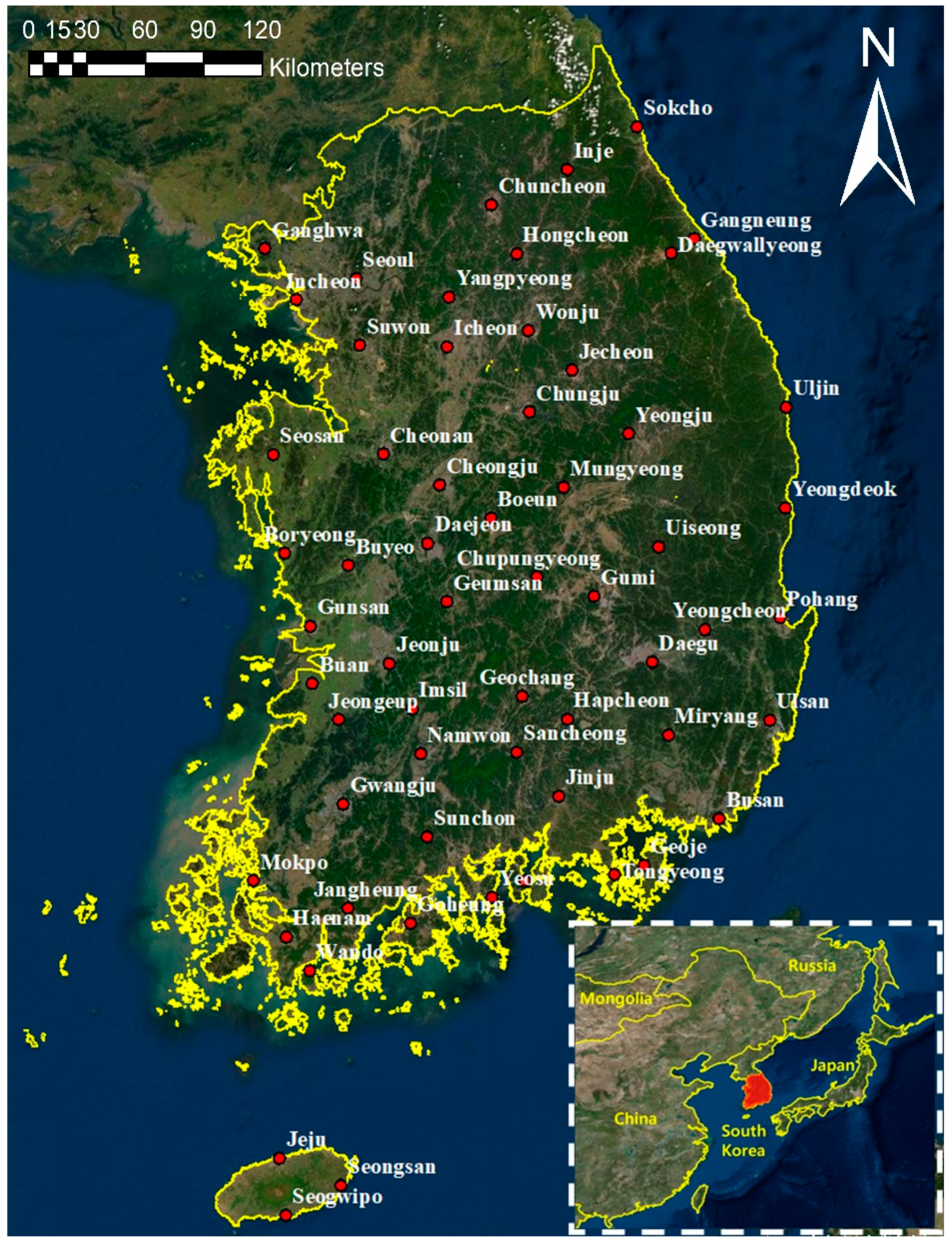
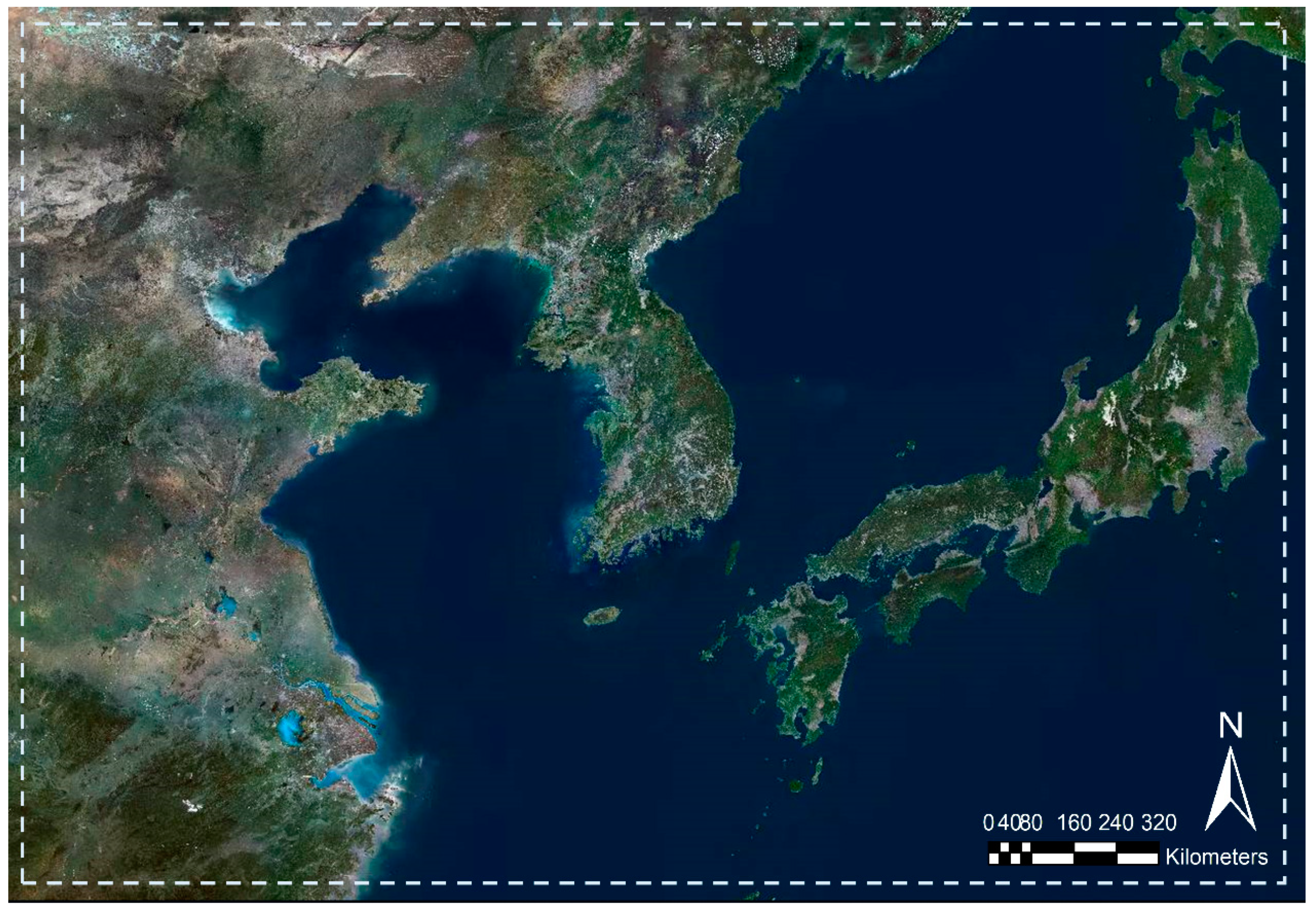

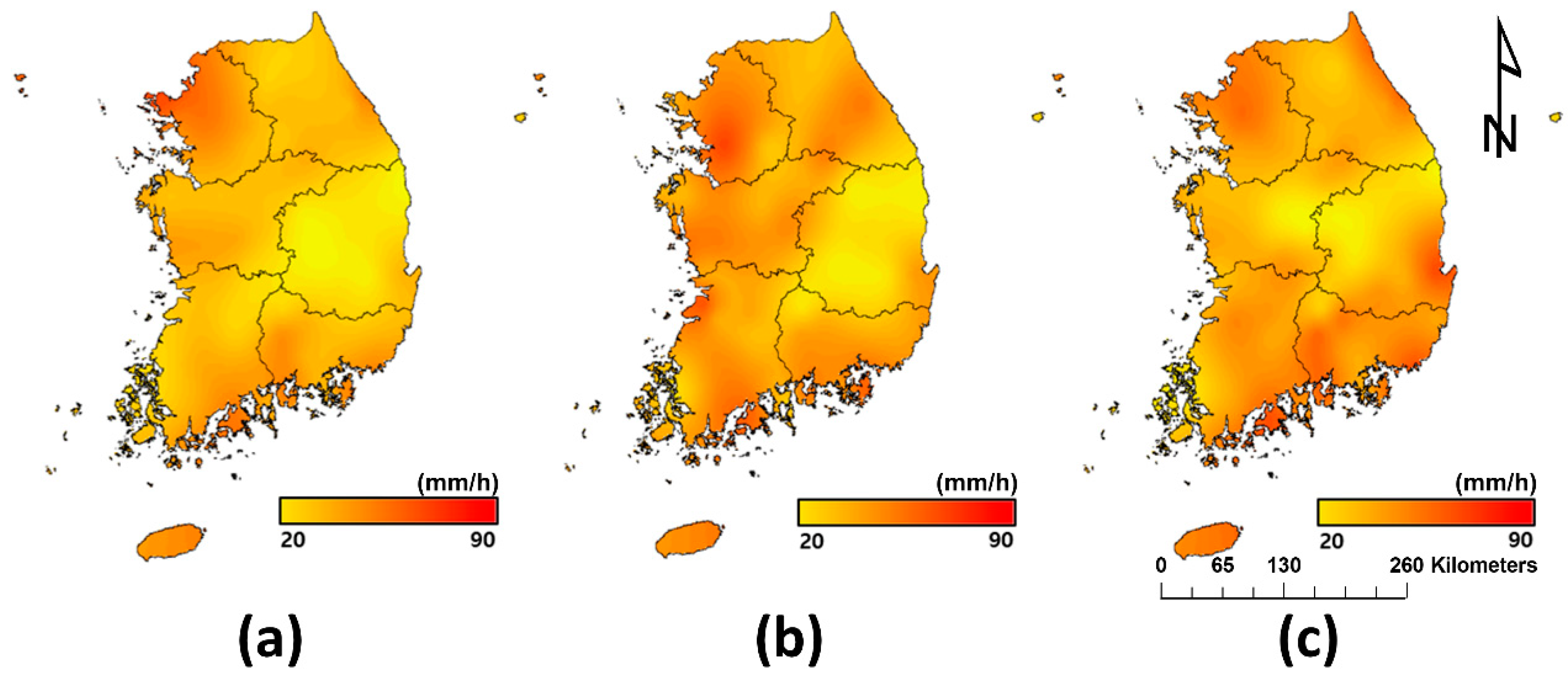
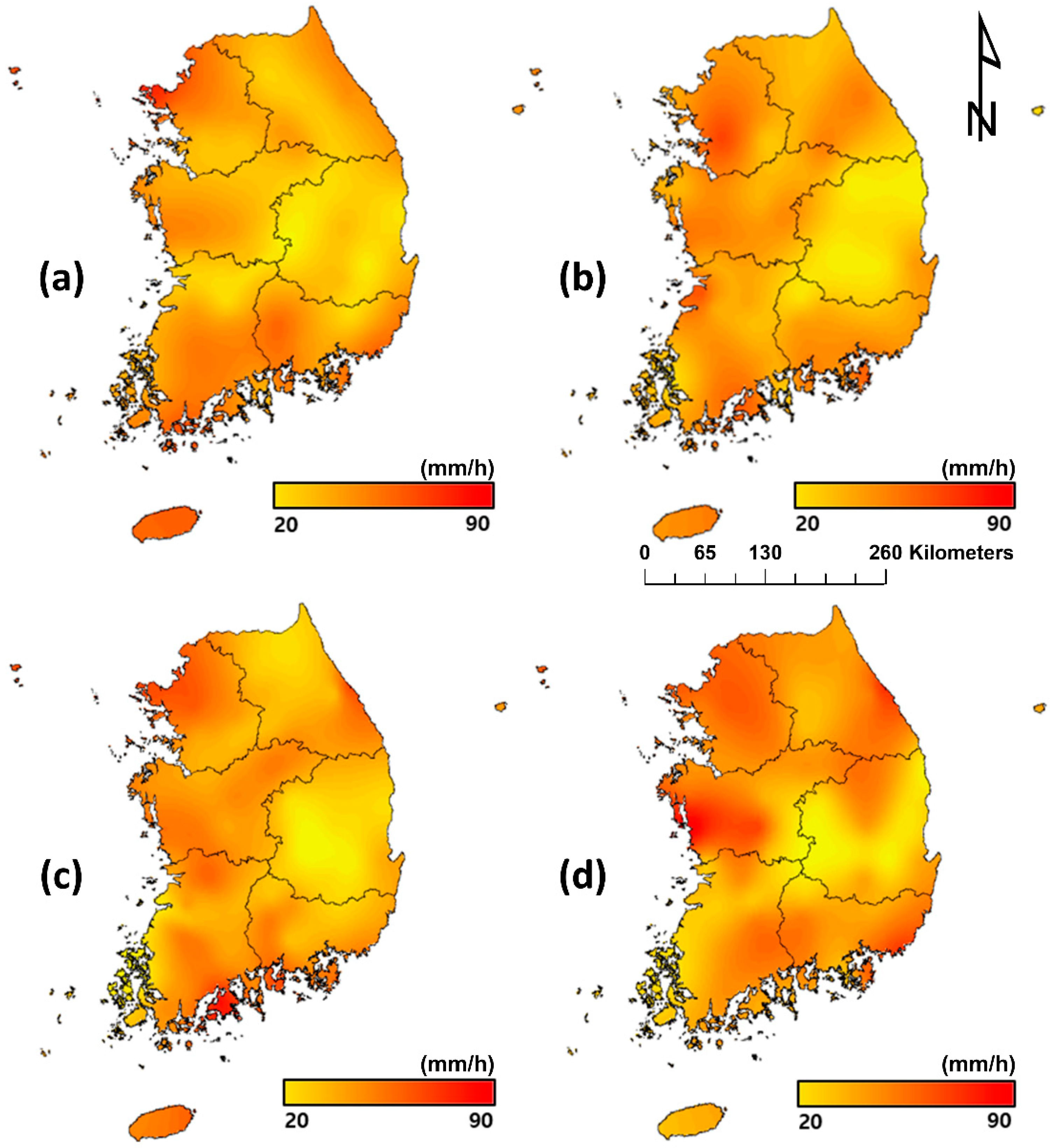
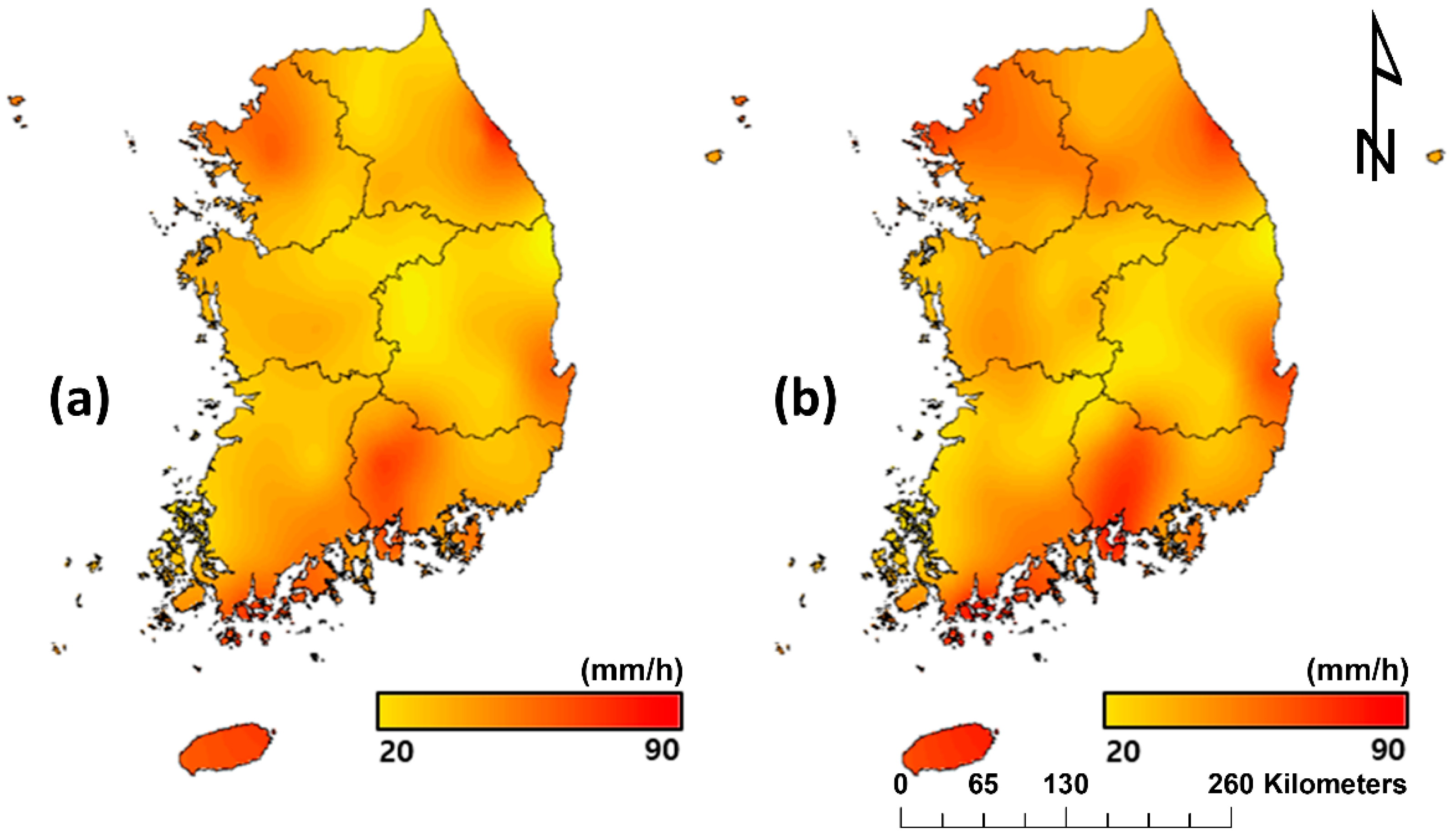
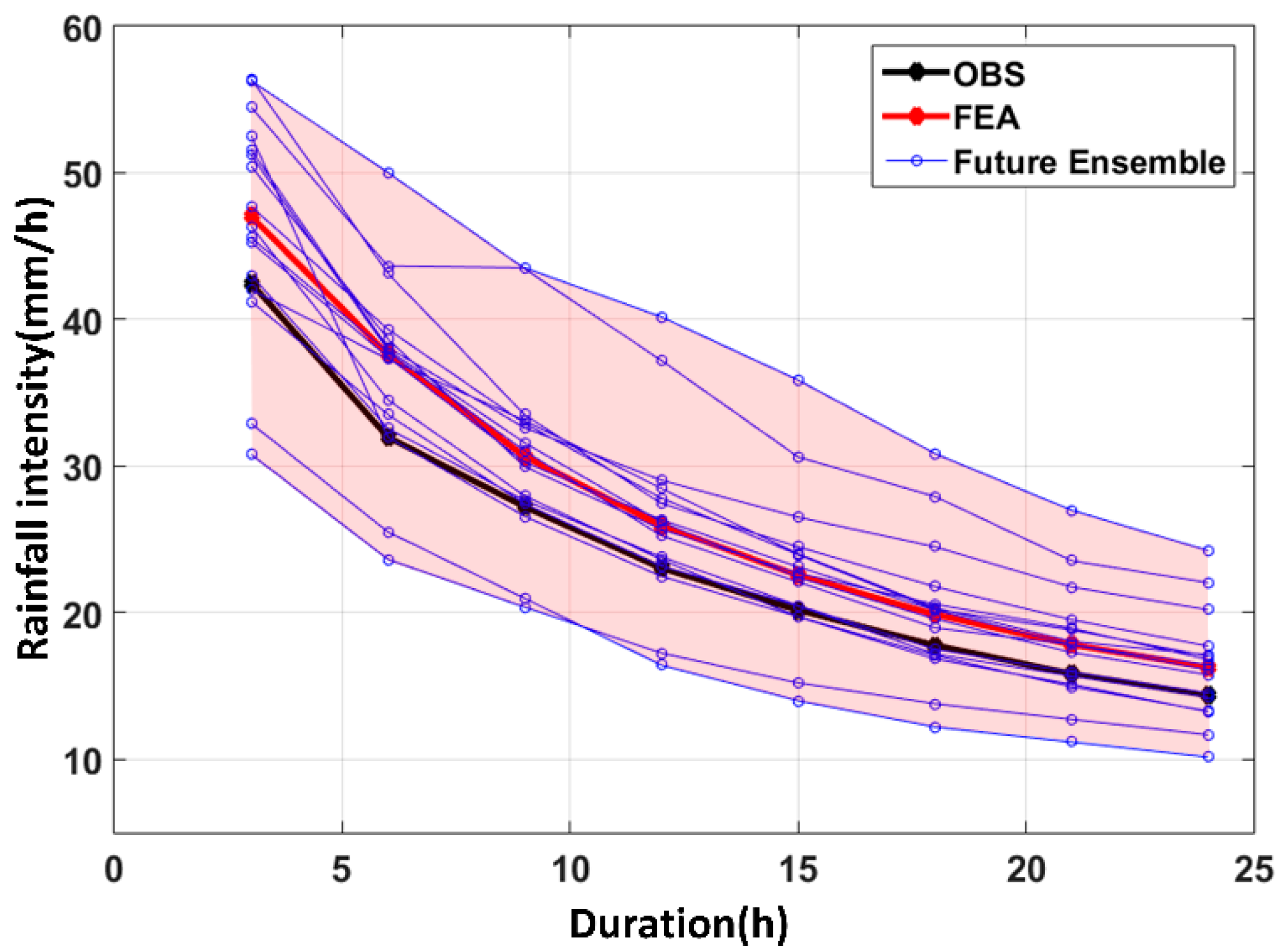
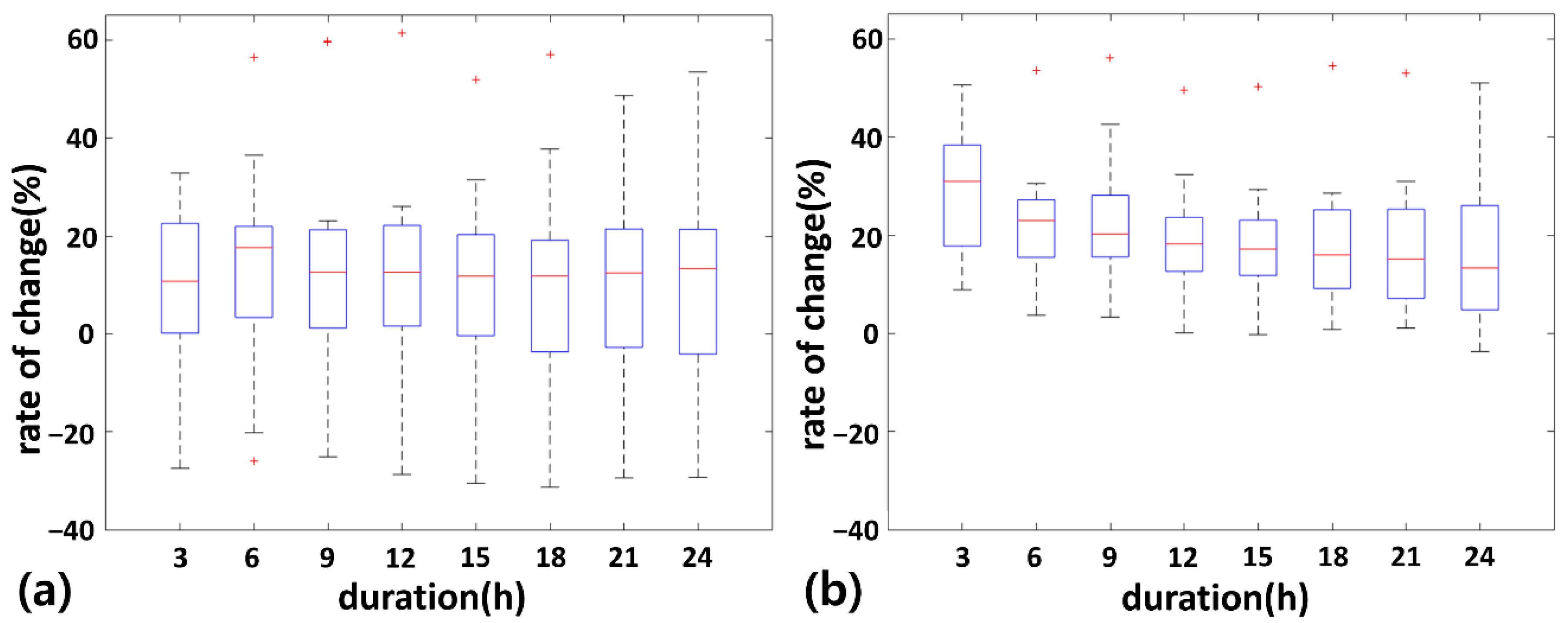

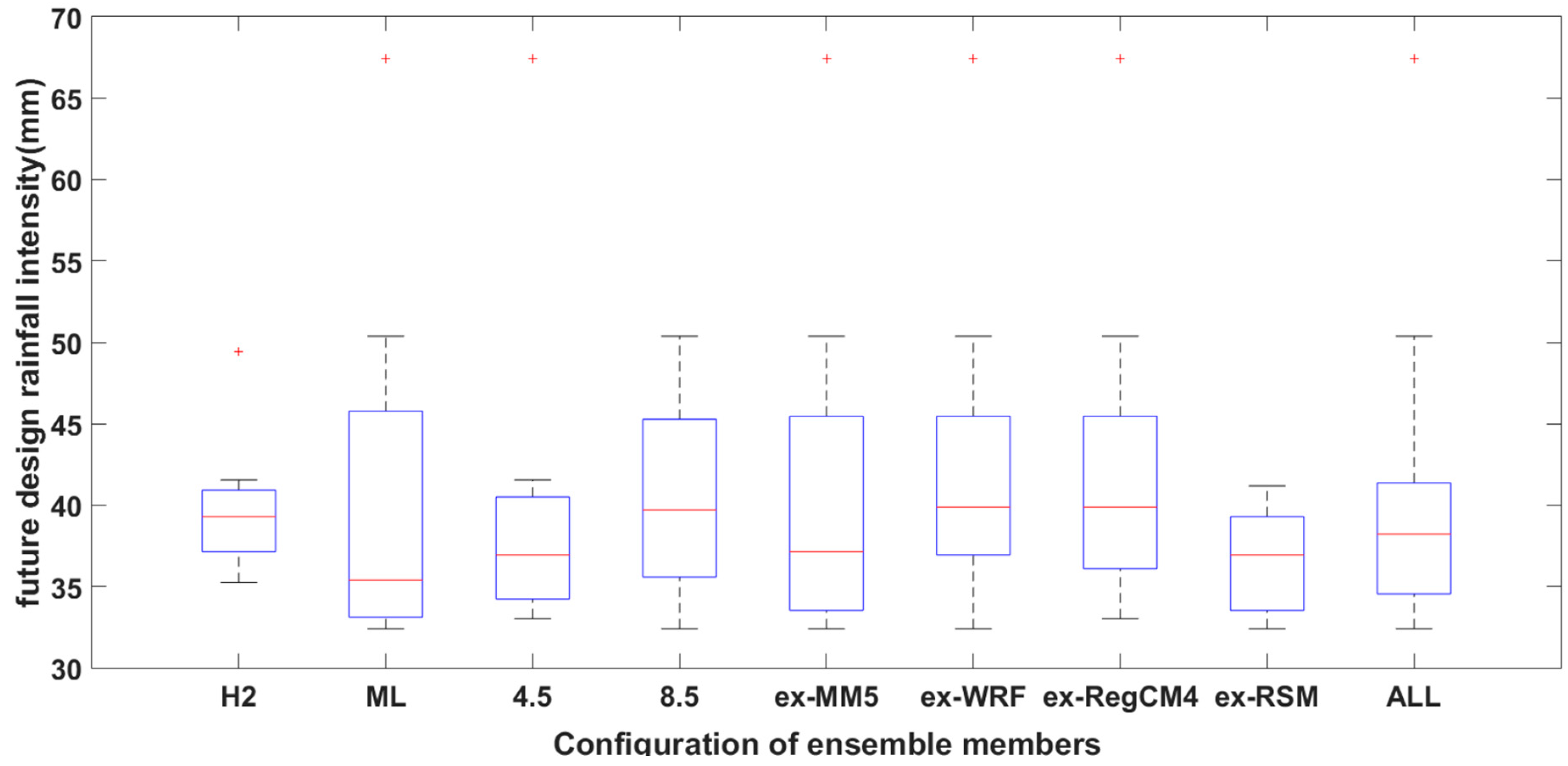
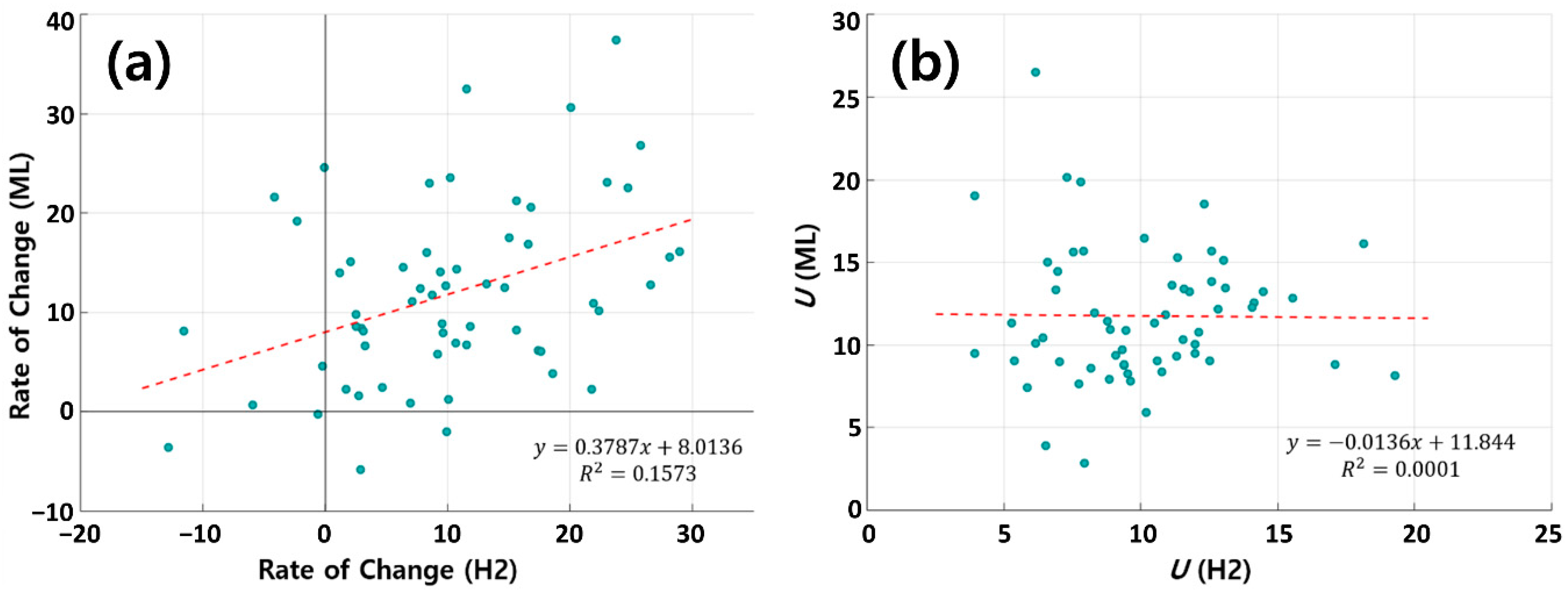
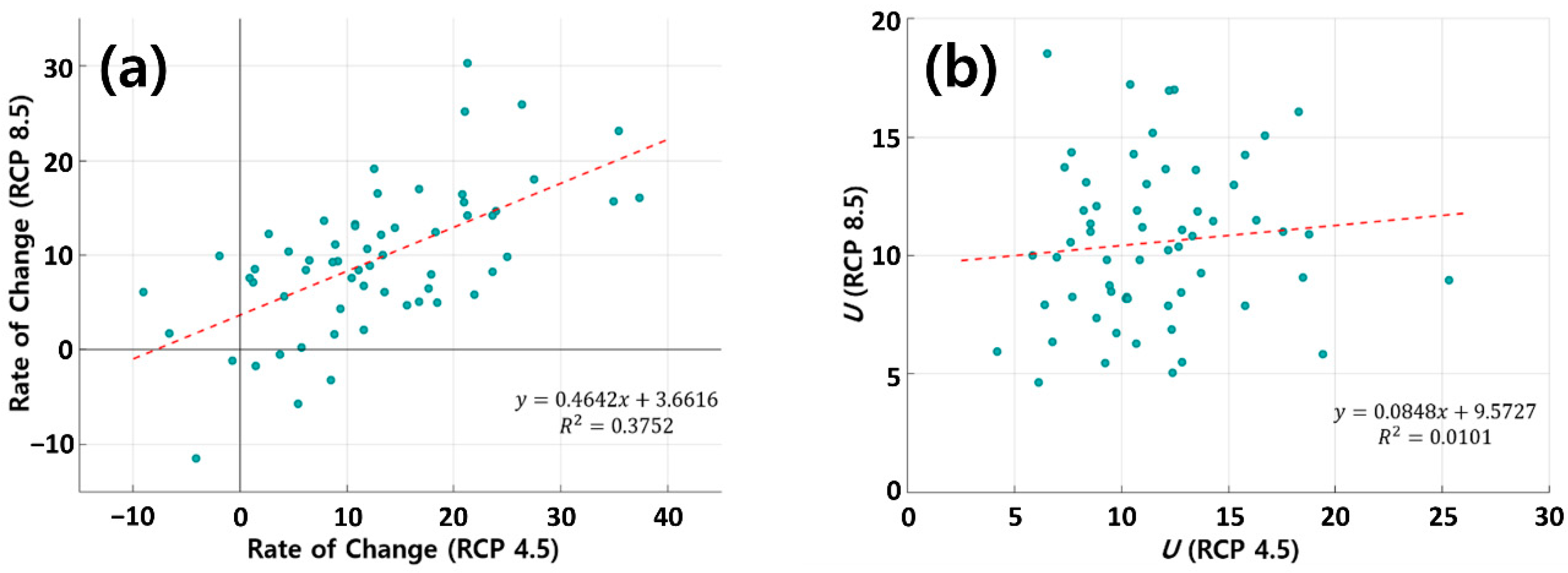
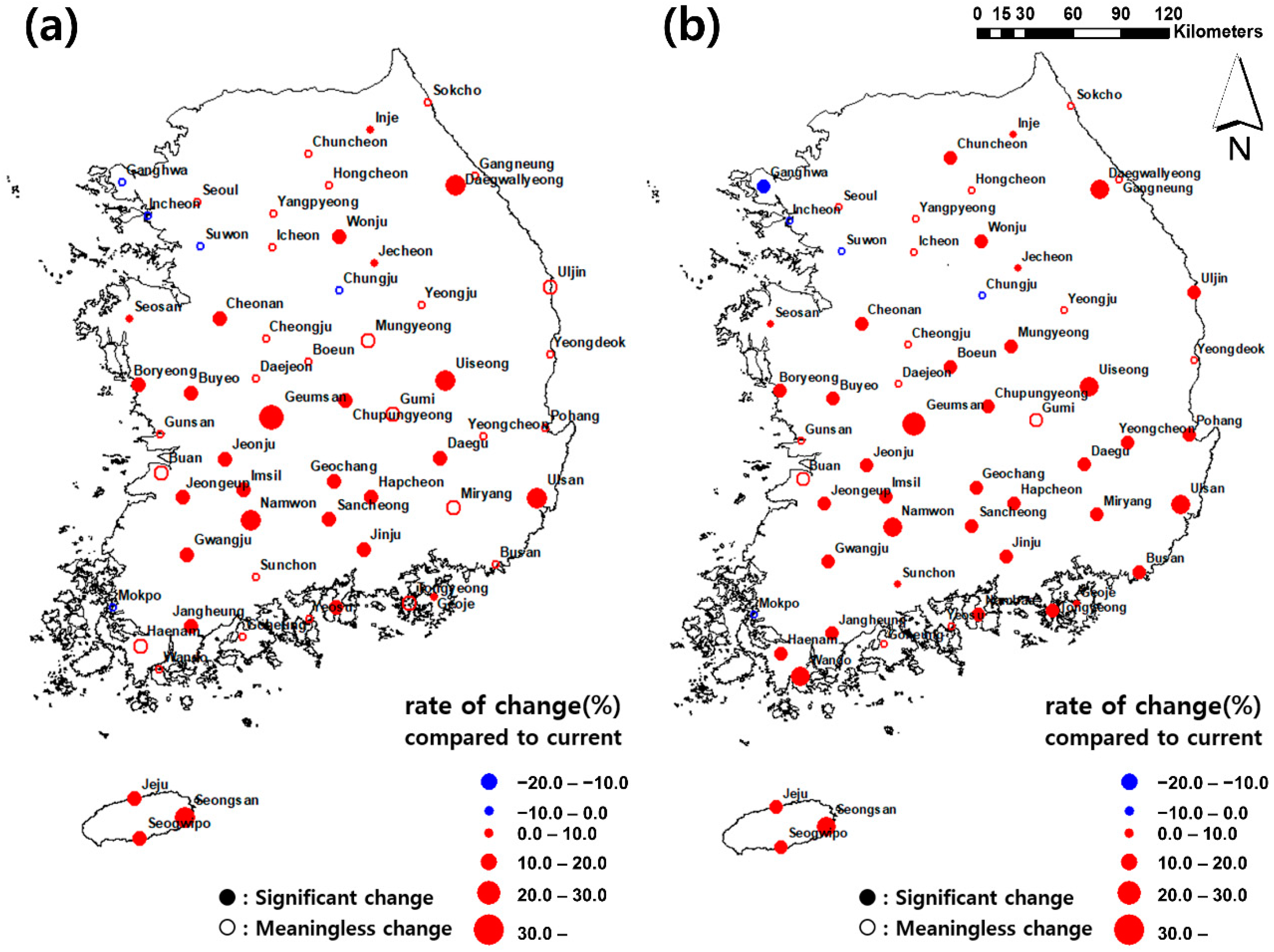
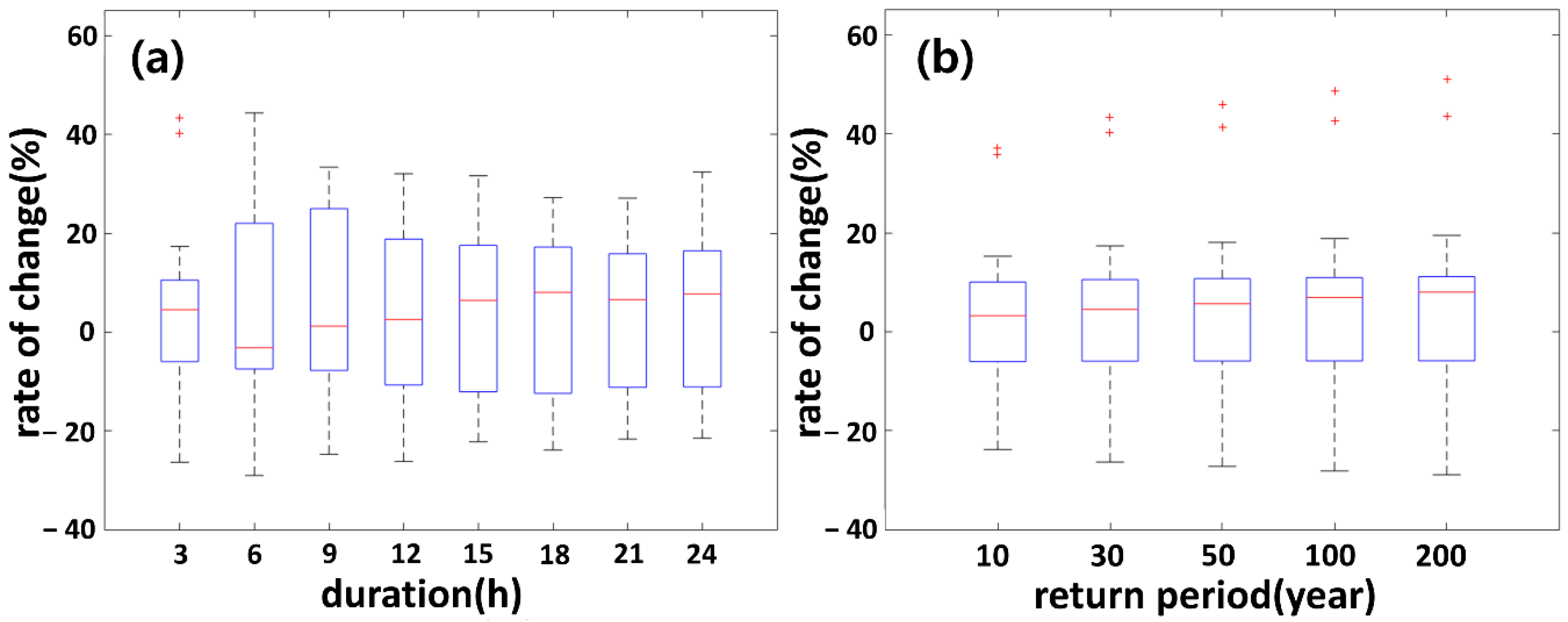
| GCMs | RCP Scenarios | RCMs | Temporal Scale | Temporal Resolution |
|---|---|---|---|---|
| MPI-ESM-LR (ML) and HadGEM2-AO (H2) | RCP 4.5 and RCP 8.5 | MM5, WRF, RegCM4, and RSM | 1981–2010 (present) 2021–2050 (future) | 3 h |
| Duration (h) | Observed Mean (mm/h) | Multi-Model Mean (Before Bias-Correction) (mm/h) | Multi-Model Mean (After Bias-Correction) (mm/h) |
|---|---|---|---|
| 3 | 27.88 | 19.13 (13.23–32.01) | 27.87 (27.73–28.01) |
| 6 | 19.47 | 14.29 (9.79–22.89) | 19.46 (19.36–19.56) |
| 12 | 12.62 | 9.58 (7.01–15.27) | 12.64 (12.60–12.68) |
| 24 | 7.71 | 5.94 (4.50–9.10) | 7.71 (7.69–7.74) |
| Site No. | Site Name | All Scenarios | RCM | ||||||||
|---|---|---|---|---|---|---|---|---|---|---|---|
| ex-MM5 | ex-WRF | ex-RegCM4 | ex-RSM | ||||||||
| (%) | 2 (%) | (%) | (%) | (%) | (%) | (%) | (%) | (%) | (%) | ||
| 90 | Sokcho | 7.1 | 13.0 | 5.7 | 11.8 | 7.1 | 12.7 | 12.5 | 12.5 | 6.4 | 14.5 |
| 100 | Daegwallyeong | 26.4 | 8.1 | 22.3 | 8.4 | 26.6 | 9.0 | 26.8 | 5.0 | 21.8 | 8.9 |
| 101 | Chuncheon | 5.7 | 8.3 | 10.4 | 8.2 | 4.5 | 8.5 | 10.2 | 8.1 | 4.1 | 8.2 |
| 105 | Gangneung | 6.1 | 13.6 | 6.1 | 13.3 | 11.7 | 12.9 | 9.9 | 14.8 | −1.9 | 12.9 |
| 108 | Seoul | 4.5 | 12.1 | 5.6 | 13.7 | 2.4 | 12.5 | 4.5 | 10.1 | 4.5 | 12.1 |
| 112 | Incheon | −0.2 | 14.9 | 1.3 | 16.6 | −1.7 | 17.0 | −0.2 | 6.6 | −0.1 | 15.7 |
| 114 | Wonju | 14.7 | 9.8 | 12.8 | 10.1 | 14.7 | 8.2 | 15.2 | 10.4 | 14.7 | 10.7 |
| 119 | Suwon | −5.9 | 12.3 | 8.5 | 11.5 | −6.8 | 8.0 | 1.5 | 13.5 | −6.6 | 13.8 |
| 127 | Chungju | −0.5 | 13.7 | 7.9 | 13.8 | −9.0 | 15.7 | −7.2 | 10.8 | 6.1 | 13.0 |
| 129 | Seosan | 9.3 | 9.0 | 11.8 | 9.2 | 11.8 | 9.5 | 9.3 | 9.6 | 6.4 | 6.4 |
| 130 | Uljin | 11.7 | 14.0 | 13.5 | 10.5 | 9.4 | 15.6 | 8.9 | 14.2 | 11.7 | 15.7 |
| 131 | Cheongju | 7.7 | 13.2 | 9.9 | 13.7 | 7.7 | 12.6 | 5.8 | 13.8 | 6.7 | 12.2 |
| 133 | Daejeon | 5.6 | 10.9 | 5.6 | 12.0 | 7.1 | 10.4 | 5.6 | 11.9 | 2.3 | 8.1 |
| 135 | Chupungyeong | 12.8 | 11.0 | 23.3 | 10.9 | 7.9 | 8.9 | 12.8 | 12.0 | 20.8 | 10.9 |
| 138 | Pohang | 6.7 | 16.8 | 3.0 | 14.6 | 6.7 | 16.7 | 3.0 | 17.9 | 19.0 | 17.1 |
| 140 | Gunsan | 1.7 | 8.7 | 5.4 | 8.7 | −1.1 | 9.7 | −4.3 | 6.6 | 4.8 | 8.6 |
| 143 | Daegu | 13.7 | 13.3 | 6.0 | 13.3 | 10.2 | 13.4 | 23.0 | 13.5 | 13.7 | 12.8 |
| 146 | Jeonju | 16.5 | 11.8 | 26.6 | 9.1 | 13.2 | 13.5 | 16.5 | 11.7 | 11.5 | 11.8 |
| 152 | Ulsan | 22.5 | 10.5 | 17.2 | 10.8 | 30.1 | 11.2 | 34.7 | 9.3 | 15.6 | 9.7 |
| 156 | Gwangju | 19.2 | 11.0 | 21.4 | 11.8 | 17.2 | 8.4 | 12.2 | 11.9 | 21.4 | 11.0 |
| 159 | Busan | 3.7 | 9.9 | 3.7 | 9.6 | 3.7 | 10.7 | 15.9 | 9.5 | 3.0 | 9.5 |
| 162 | Tongyeong | 11.1 | 11.3 | 5.7 | 13.1 | 11.1 | 12.8 | 12.3 | 10.7 | 11.1 | 7.9 |
| 165 | Mokpo | −0.7 | 8.0 | −4.5 | 7.6 | 2.9 | 8.2 | −0.7 | 7.0 | −0.7 | 8.8 |
| 168 | Yeosu | 5.0 | 14.5 | 5.7 | 15.8 | 5.0 | 15.2 | 4.0 | 16.6 | 4.1 | 8.5 |
| 170 | Wando | 9.5 | 12.7 | 4.8 | 10.9 | 9.8 | 14.0 | 10.5 | 11.7 | 20.4 | 13.0 |
| 184 | Jeju | 10.6 | 7.4 | 13.5 | 8.0 | 14.5 | 7.6 | 13.4 | 6.4 | 6.2 | 7.0 |
| 188 | Seongsan | 23.1 | 12.3 | 17.7 | 13.6 | 26.8 | 12.7 | 25.1 | 8.6 | 23.1 | 13.6 |
| 189 | Seogwipo | 11.7 | 9.7 | 14.6 | 9.6 | 14.8 | 9.8 | 9.2 | 10.6 | 7.6 | 7.5 |
| 192 | Jinju | 16.6 | 12.9 | 15.6 | 11.5 | 16.2 | 14.6 | 25.9 | 12.7 | 17.4 | 11.8 |
| 201 | Ganghwa | −8.1 | 12.3 | −10 | 11.8 | −1.6 | 10.8 | −13.9 | 12.6 | −1.6 | 12.8 |
| 202 | Yangpyeong | 6.4 | 8.1 | 5.2 | 8.0 | 6.4 | 9.1 | 7.0 | 8.6 | 4.6 | 5.8 |
| 203 | Icheon | 4.7 | 9.8 | 5.0 | 10.2 | 4.7 | 9.1 | 4.7 | 11.0 | 2.1 | 9.0 |
| 211 | Inje | 9.7 | 7.0 | 9.3 | 7.5 | 14.2 | 7.7 | 11.5 | 5.3 | 8.4 | 6.9 |
| 212 | Hongcheon | 4.0 | 5.8 | 4.0 | 5.8 | 4.6 | 6.8 | 4.1 | 5.2 | 3.6 | 5.4 |
| 221 | Jecheon | 9.1 | 9.0 | 10.3 | 8.0 | 4.4 | 10.1 | 7.5 | 7.3 | 9.1 | 10.2 |
| 226 | Boeun | 7.0 | 13.8 | 15.8 | 15.0 | 6.0 | 11.3 | 4.1 | 14.6 | 19.6 | 13.5 |
| 232 | Cheonan | 13.1 | 9.0 | 13.8 | 9.8 | 14.1 | 9.6 | 10.3 | 7.8 | 14.1 | 8.4 |
| 235 | Boryeong | 17.0 | 14.6 | 21.8 | 14.9 | 18.4 | 16.1 | 17.0 | 14.7 | 5.9 | 11.6 |
| 236 | Buyeo | 11.2 | 11.1 | 14.1 | 12.3 | 13.2 | 12.4 | 4.2 | 12.2 | 14.1 | 6.7 |
| 238 | Geumsan | 31.0 | 7.0 | 32.5 | 5.5 | 23.8 | 8.0 | 27.7 | 7.4 | 32.5 | 6.8 |
| 243 | Buan | 13.3 | 14.6 | 14.9 | 14.8 | 3.4 | 10.4 | 9.9 | 16.2 | 14.9 | 15.2 |
| 244 | Imsil | 18.4 | 10.1 | 27.2 | 9.4 | 11.0 | 9.3 | 12.6 | 10.6 | 25.0 | 10.1 |
| 245 | Jeongeup | 12.7 | 8.8 | 12.7 | 8.8 | 8.2 | 9.1 | 15.2 | 8.7 | 6.7 | 8.7 |
| 247 | Namwon | 24.3 | 11.0 | 24.3 | 11.1 | 22.0 | 12.6 | 25.9 | 12.2 | 22.2 | 7.4 |
| 256 | Suncheon | 8.6 | 9.5 | 6.7 | 11.0 | 10.5 | 9.5 | 10.5 | 10.8 | 8.6 | 6.4 |
| 260 | Jangheung | 16.4 | 5.3 | 15.9 | 6.0 | 16.4 | 5.1 | 18.3 | 5.1 | 16.0 | 5.3 |
| 261 | Haenam | 10.7 | 10.9 | 6.9 | 11.5 | 19.7 | 12.2 | 10.7 | 7.0 | 10.7 | 12.0 |
| 262 | Goheung | 6.7 | 15.4 | 6.7 | 17.2 | −5.5 | 18.0 | 6.7 | 10.3 | 6.9 | 14.9 |
| 272 | Yeongju | 1.9 | 14.3 | 5.4 | 15.6 | 3.8 | 14.6 | 1.9 | 16.1 | −0.1 | 7.2 |
| 273 | Mungyeong | 13.6 | 9.3 | 15.1 | 10.0 | 12.1 | 6.9 | 10.0 | 10.5 | 15.2 | 8.8 |
| 277 | Yeongdeok | 7.8 | 14.6 | 7.8 | 15.6 | 7.8 | 12.5 | 6.2 | 16.3 | 10.4 | 13.8 |
| 278 | Uiseong | 25.4 | 14.8 | 21.9 | 17.1 | 30.8 | 15.2 | 30.8 | 15.4 | 21.2 | 5.6 |
| 279 | Gumi | 15.1 | 20.5 | 9.5 | 22.2 | 19.5 | 22.5 | 19.5 | 21.3 | 15.1 | 13.8 |
| 281 | Yeongcheon | 9.2 | 10.8 | 8.6 | 11.4 | 8.6 | 9.2 | 15.6 | 11.6 | 14.2 | 10.0 |
| 284 | Geochang | 14.7 | 13.0 | 12.7 | 11.5 | 35.1 | 12.6 | 23.6 | 12.9 | 13.5 | 14.0 |
| 285 | Hapcheon | 18.9 | 12.1 | 16.9 | 8.3 | 18.9 | 12.8 | 18.8 | 13.7 | 19.7 | 11.8 |
| 288 | Miryang | 10.1 | 10.7 | 12.1 | 10.6 | 2.0 | 10.6 | 12.1 | 10.7 | 5.4 | 10.7 |
| 289 | Sancheong | 18.9 | 10.2 | 10.5 | 6.6 | 18.9 | 10.4 | 21.1 | 11.5 | 21.1 | 10.8 |
| 294 | Geoje | 8.8 | 8.7 | 11.1 | 10.1 | 8.8 | 9.7 | 14.7 | 6.9 | 7.3 | 6.9 |
| 295 | Namhae | 12.9 | 9.0 | 12.9 | 8.7 | 15.4 | 9.3 | 15.0 | 10.1 | 10.9 | 7.8 |
| Average | 10.8 | 11.3 | 11.4 | 11.3 | 10.8 | 11.4 | 11.7 | 11.0 | 10.9 | 10.3 | |
© 2019 by the authors. Licensee MDPI, Basel, Switzerland. This article is an open access article distributed under the terms and conditions of the Creative Commons Attribution (CC BY) license (http://creativecommons.org/licenses/by/4.0/).
Share and Cite
Kim, K.; Choi, J.; Lee, O.; Cha, D.-H.; Kim, S. Uncertainty Quantification of Future Design Rainfall Depths in Korea. Atmosphere 2020, 11, 22. https://doi.org/10.3390/atmos11010022
Kim K, Choi J, Lee O, Cha D-H, Kim S. Uncertainty Quantification of Future Design Rainfall Depths in Korea. Atmosphere. 2020; 11(1):22. https://doi.org/10.3390/atmos11010022
Chicago/Turabian StyleKim, Kyungmin, Jeonghyeon Choi, Okjeong Lee, Dong-Hyun Cha, and Sangdan Kim. 2020. "Uncertainty Quantification of Future Design Rainfall Depths in Korea" Atmosphere 11, no. 1: 22. https://doi.org/10.3390/atmos11010022
APA StyleKim, K., Choi, J., Lee, O., Cha, D.-H., & Kim, S. (2020). Uncertainty Quantification of Future Design Rainfall Depths in Korea. Atmosphere, 11(1), 22. https://doi.org/10.3390/atmos11010022






